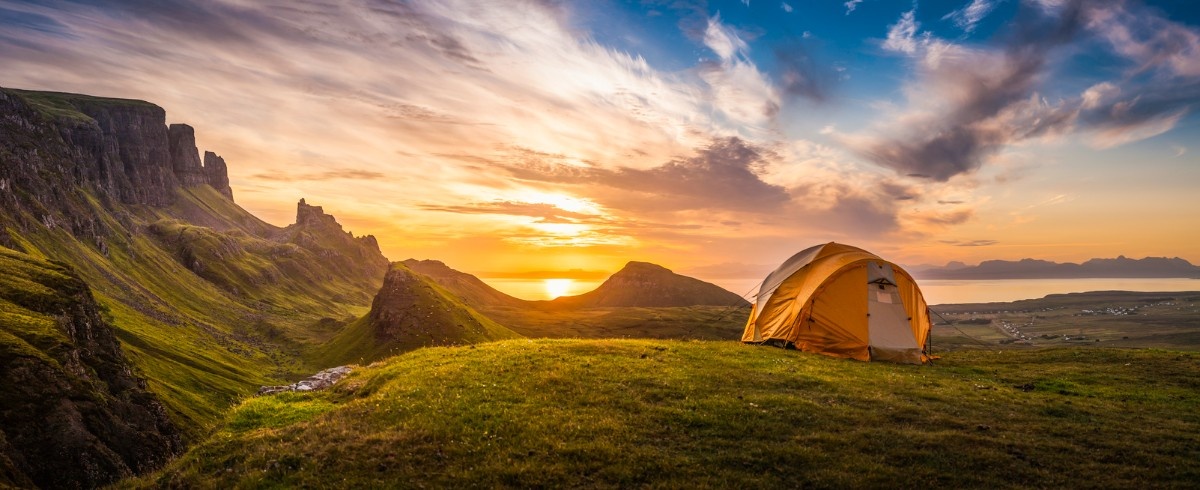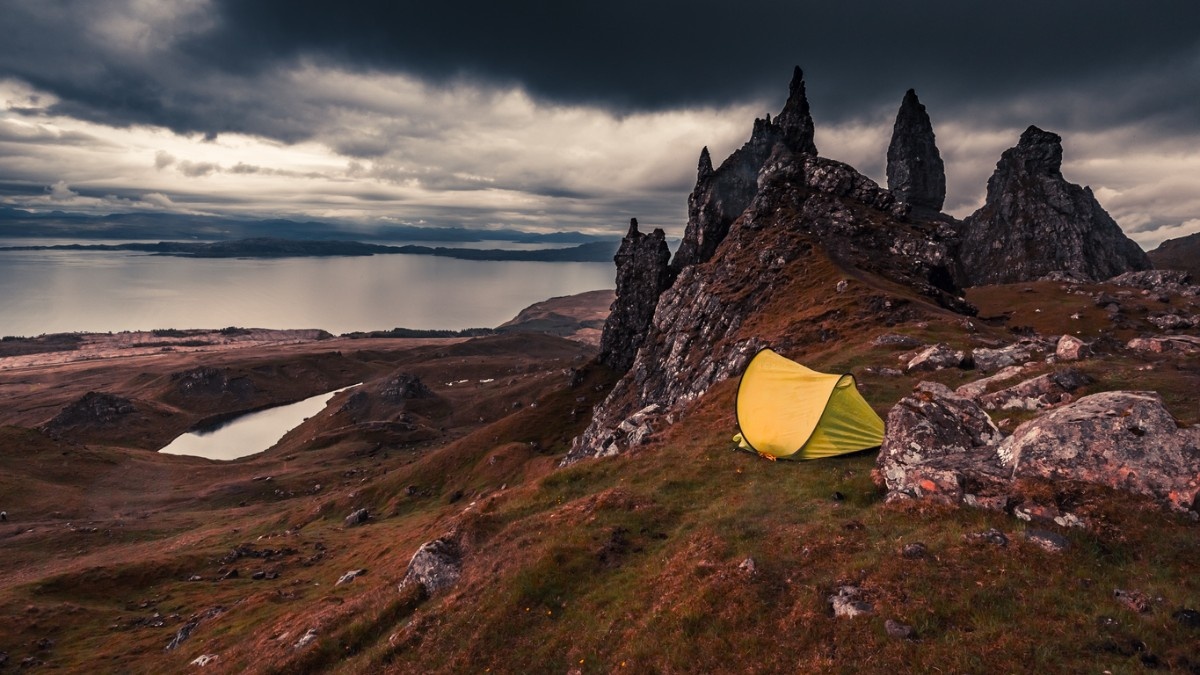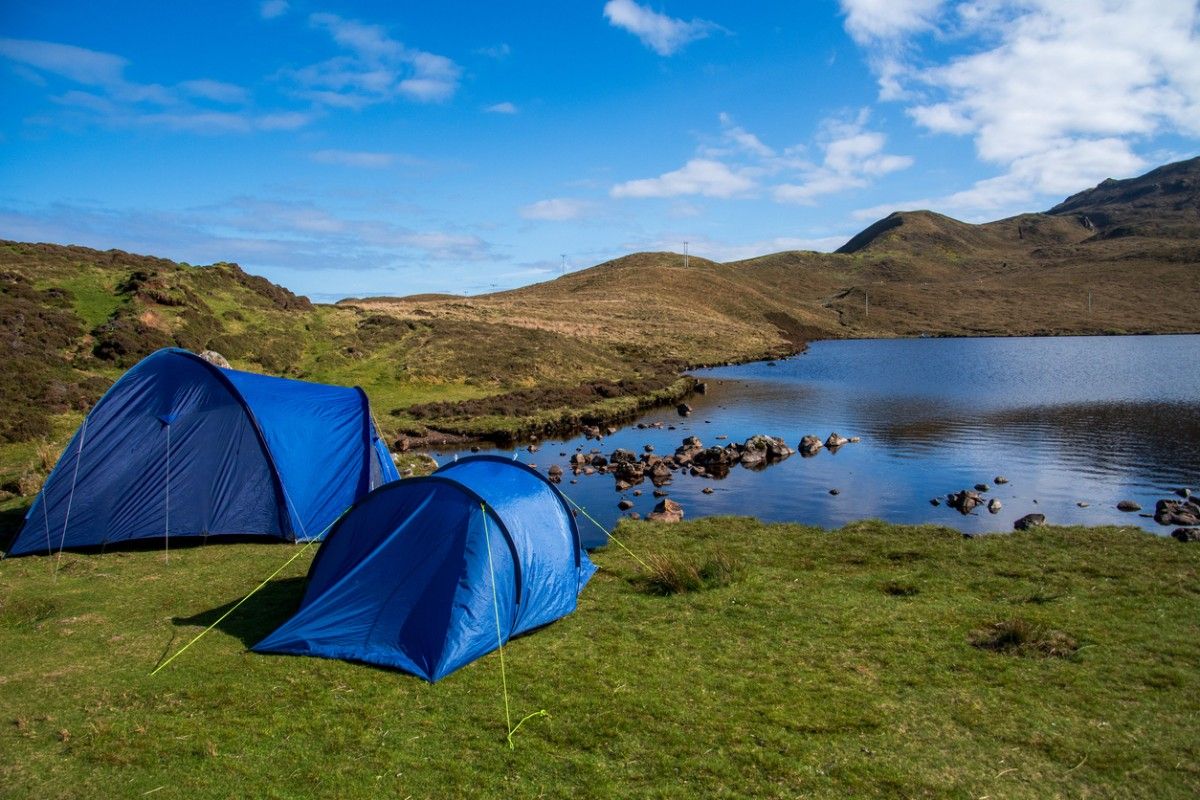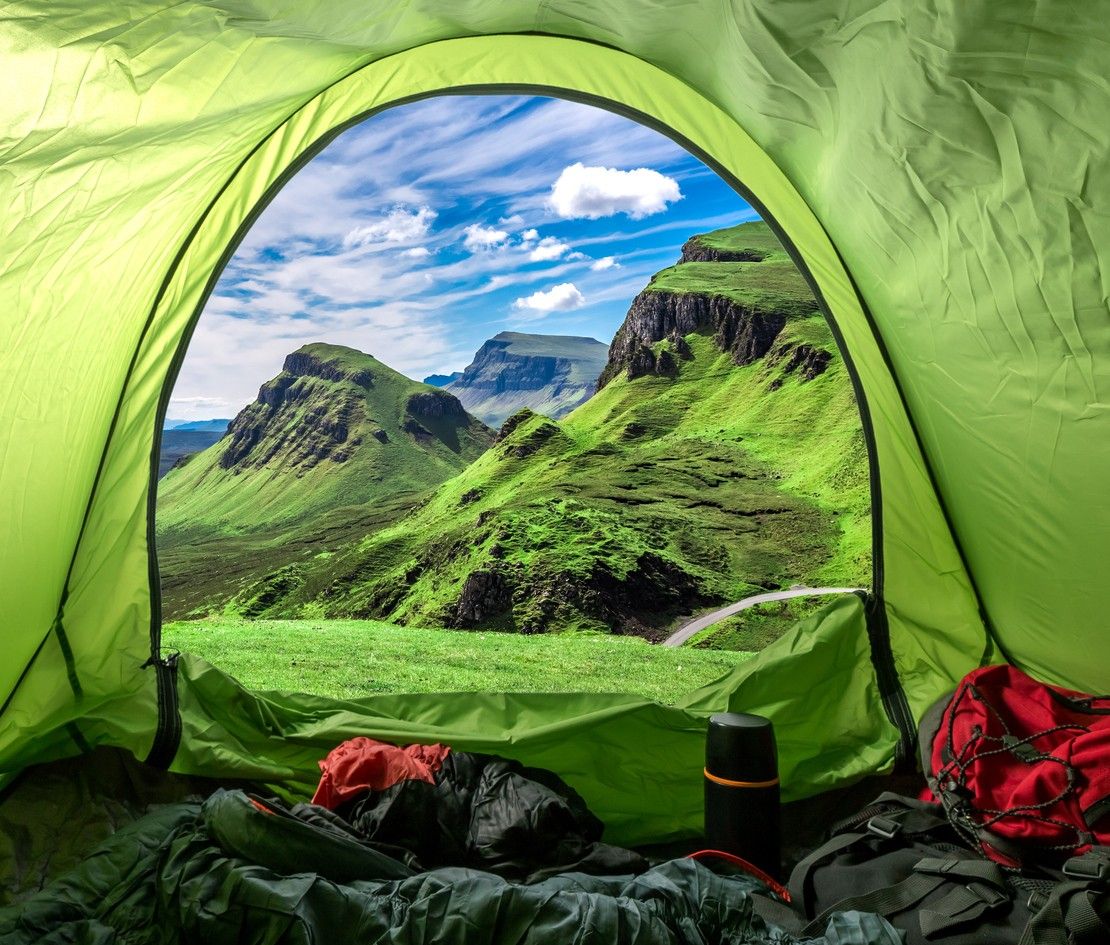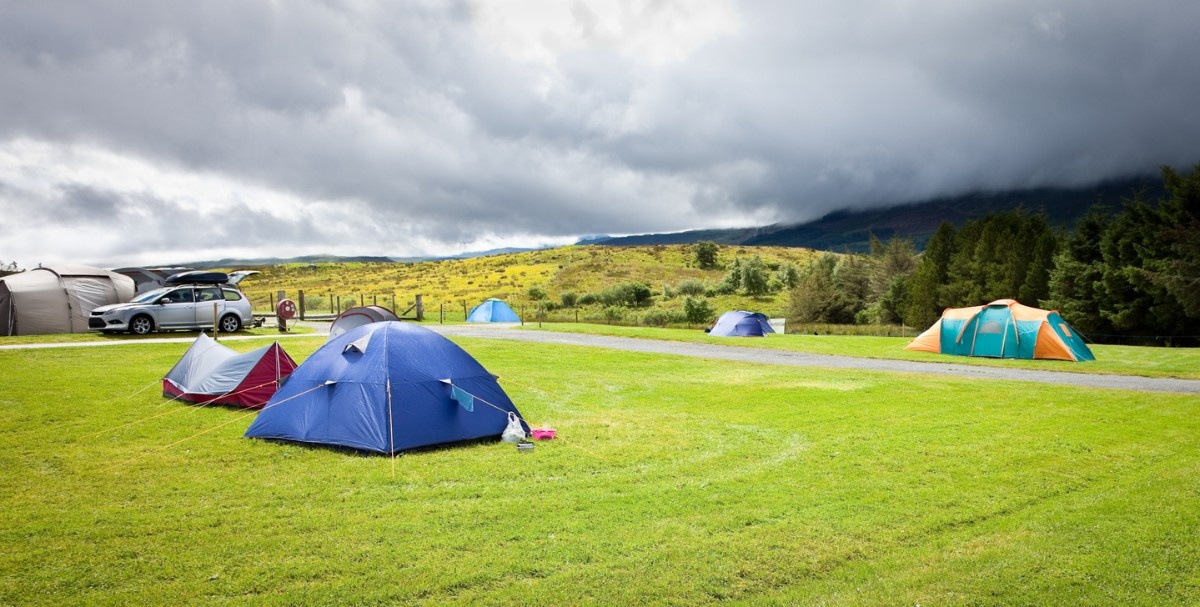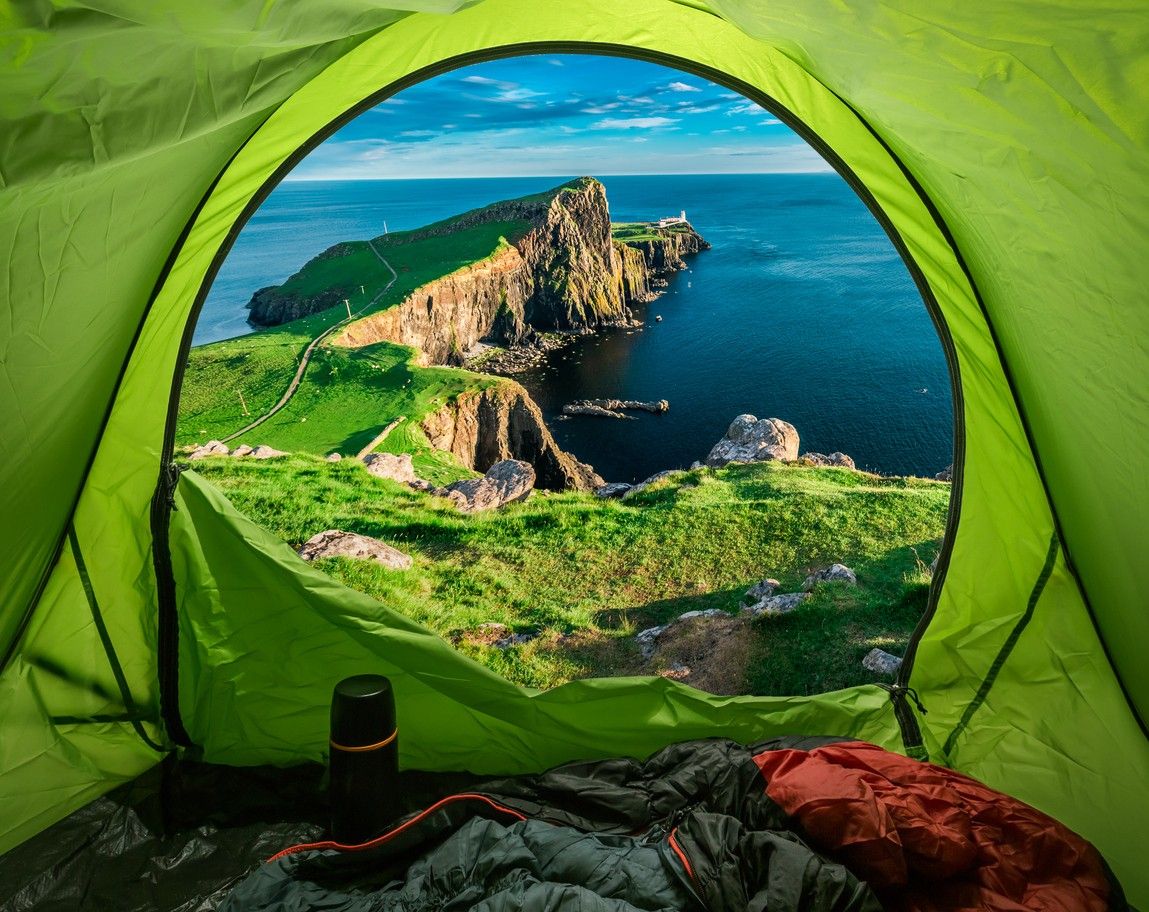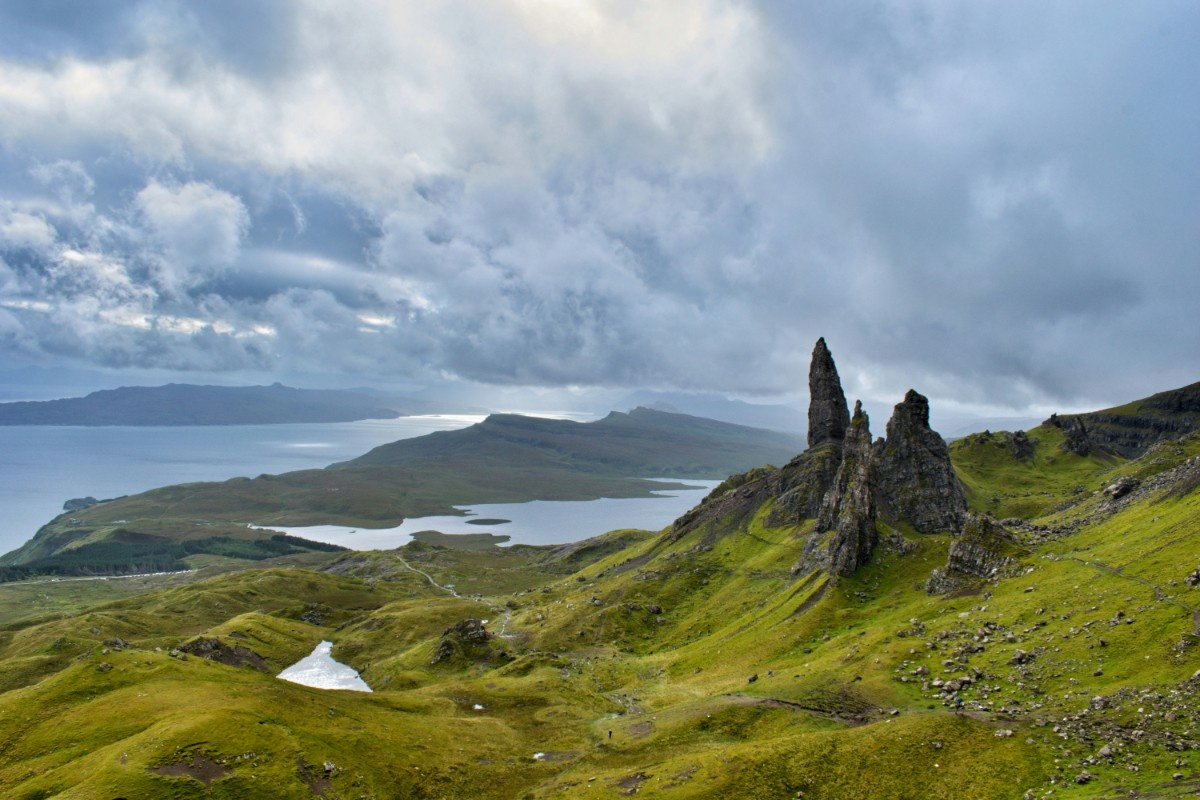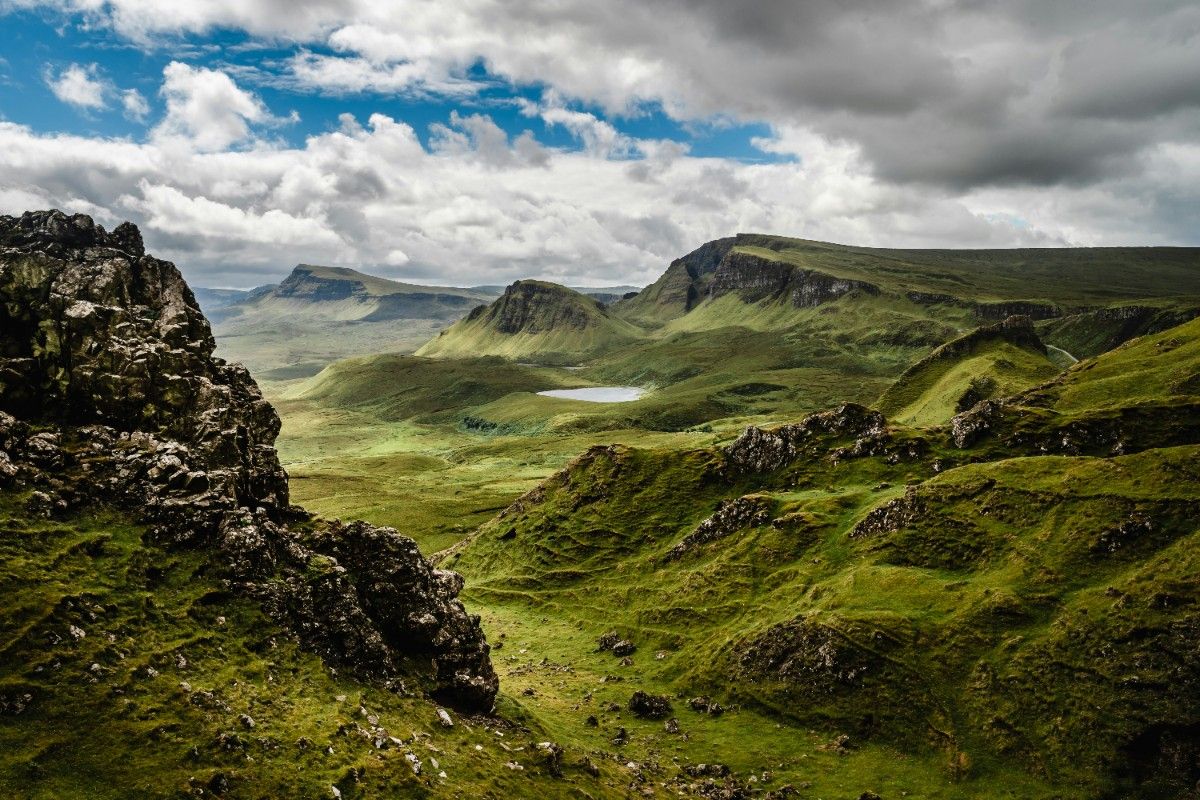The Allure of Camping on the Isle of Skye
A Paradise for Nature Enthusiasts
The Isle of Skye, situated off the northwest coast of Scotland, is a captivating destination that beckons outdoor enthusiasts and nature lovers from around the world. With its breathtaking landscapes, rugged coastlines, and majestic mountains, Skye offers an unparalleled camping experience. The island's stunning scenery, diverse wildlife, and rich history create an enchanting atmosphere that draws visitors seeking to immerse themselves in the raw beauty of the Scottish Highlands.
Camping on the Isle of Skye allows adventurers to disconnect from the hustle and bustle of modern life and forge a deep connection with the natural world. As you pitch your tent amidst the island's rolling hills, beside crystal-clear streams, or along the dramatic coastline, you'll find yourself enveloped in a sense of tranquillity and awe. The island's pristine environment and serene ambiance provide a much-needed respite from the stresses of everyday life, allowing campers to unwind, recharge, and reconnect with the essentials.
One of the most appealing aspects of camping on Skye is the opportunity to witness the island's incredible biodiversity. The Isle of Skye is home to a wide array of flora and fauna, including rare and endangered species. From the majestic golden eagles soaring overhead to the elusive otters playing along the shoreline, the island's wildlife adds an extra layer of magic to the camping experience. Nature enthusiasts can spend countless hours exploring the island's diverse habitats, from the windswept moors and ancient forests to the secluded beaches and rugged sea cliffs.
Moreover, camping on the Isle of Skye grants access to some of the most spectacular stargazing opportunities in Europe. With minimal light pollution and vast expanses of open sky, the island offers breathtaking views of the Milky Way and countless constellations. On clear nights, campers can marvel at the celestial wonders above, feeling a profound sense of connection to the universe and the natural world around them.
A Gateway to Adventure
Beyond its natural beauty, the Isle of Skye is a paradise for adventure seekers. The island offers a wide range of outdoor activities and challenges that cater to all levels of experience and fitness. Camping on Skye provides an ideal base for exploring the island's rugged terrain and embarking on thrilling pursuits.
Hiking enthusiasts will find themselves in heaven on the Isle of Skye. The island boasts numerous iconic trails, such as the Old Man of Storr, the Quiraing, and the Cuillin Ridge, each offering unique landscapes and breathtaking vistas. From gentle coastal walks to strenuous mountain scrambles, there's a route to suit every adventurer's taste. As you traverse the island's stunning terrain, you'll discover hidden waterfalls, ancient rock formations, and secluded glens that will leave you in awe of Skye's raw beauty.
For those seeking water-based adventures, the Isle of Skye's coastline and inland lochs provide ample opportunities for kayaking, paddleboarding, and wild swimming. Exploring the island's sheltered bays, sea caves, and rugged shorelines from the water offers a unique perspective and a chance to spot seals, dolphins, and seabirds up close. The crystal-clear waters of the Fairy Pools and the serene beauty of Loch Coruisk are must-visit destinations for any water enthusiast.
Camping on the Isle of Skye also allows adventurers to try their hand at rock climbing and mountaineering. The island's dramatic geology, particularly in the Cuillin Mountains, presents challenges for climbers of all skill levels. With the help of experienced guides, even novice climbers can safely tackle some of Skye's most iconic peaks and ridges, experiencing the thrill of reaching the summit and taking in the awe-inspiring views.
Ultimately, the allure of camping on the Isle of Skye lies in the opportunity to immerse oneself in the island's untamed beauty, to disconnect from the trappings of modern life, and to embark on unforgettable adventures. Whether you're seeking solitude and tranquillity or adrenaline-pumping thrills, the Isle of Skye promises an extraordinary camping experience that will leave an indelible mark on your soul.
Isle of Skye Camping Destinations: A Guide to the Best Spots
Glenbrittle Campsite: A Gateway to the Cuillin Mountains
Nestled at the foot of the majestic Cuillin Mountains, Glenbrittle Campsite is a premier camping destination on the Isle of Skye. This picturesque site offers breathtaking views of the rugged peaks and the crystal-clear waters of Loch Brittle, creating an enchanting setting for your camping adventure.
Glenbrittle Campsite caters to both tent campers and those seeking a bit more comfort in the form of camping pods. The well-maintained grounds provide ample space for pitching your tent, with nearby amenities such as clean toilets, hot showers, and a small shop stocked with essential supplies. For those opting for the camping pods, these cozy structures offer a more luxurious experience, complete with heating, lighting, and comfortable bedding.
One of the main draws of Glenbrittle Campsite is its unparalleled access to the Cuillin Mountains. The site serves as a perfect base for hiking and climbing expeditions into the heart of these iconic peaks. The challenging Cuillin Ridge traverse, a must-do for experienced mountaineers, begins just a stone's throw from the campsite. Less strenuous but equally rewarding hikes, such as the Fairy Pools and the Talisker Bay coastal walk, are also within easy reach.
After a day of exploration and adventure, Glenbrittle Campsite offers a peaceful retreat where you can unwind and recharge. The site's beachfront location allows for stunning sunset views over the loch, while the nearby river provides a soothing soundtrack to lull you to sleep. The campsite's friendly and knowledgeable staff are always on hand to offer advice and assistance, ensuring that your stay is as comfortable and enjoyable as possible.
Sligachan Campsite: Where Wilderness Meets Comfort
Sligachan Campsite, located in the heart of the Isle of Skye, is another must-visit camping destination for outdoor enthusiasts. Situated at the convergence of the Black and Red Cuillin mountain ranges, this campsite offers a perfect blend of wilderness and comfort, making it an ideal choice for those seeking a memorable camping experience on Skye.
The campsite boasts spacious pitches for tents, as well as a selection of well-appointed camping pods and cabins. The pods provide a cozy and dry retreat, complete with electricity, heating, and comfortable beds, while the cabins offer a more spacious and luxurious option for families or groups of friends. All campers have access to modern amenities, including clean toilets, hot showers, and a well-equipped kitchen area.
Sligachan Campsite is renowned for its stunning location and easy access to some of Skye's most iconic hiking trails. The campsite sits at the trailhead of the popular Sligachan to Elgol coastal walk, a scenic route that winds through the heart of the Cuillin Mountains and offers breathtaking views of the sea and the surrounding landscape. Other notable hikes in the area include the ascent of Marsco, a challenging but rewarding climb that offers panoramic vistas of the island, and the tranquil walk to the secluded Camasunary Bay.
One of the highlights of staying at Sligachan Campsite is the opportunity to enjoy the amenities of the nearby Sligachan Hotel. This historic establishment, dating back to the 1830s, offers a warm and inviting atmosphere, complete with a well-stocked bar, a cozy lounge, and an excellent restaurant serving locally sourced produce. After a day of exploring the island's rugged beauty, there's nothing quite like retreating to the hotel for a pint of local ale and a hearty meal.
Sligachan Campsite also serves as an excellent base for exploring the Isle of Skye's rich history and culture. The nearby village of Sconser is home to the Isle of Skye Golf Club, one of the oldest golf courses in Scotland, as well as the ruins of the historic Dun Sgathaich castle. A short drive from the campsite, you'll find the iconic Sligachan Bridge, a picturesque spot steeped in local folklore and legend.
Whether you're a seasoned camper or a first-time visitor to the Isle of Skye, Sligachan Campsite offers an unforgettable camping experience that combines the raw beauty of the island's wilderness with the comfort and convenience of modern amenities. With its stunning location, easy access to iconic hiking trails, and the charming ambiance of the nearby Sligachan Hotel, this campsite is an essential destination for any camping adventure on Skye.
Wild Camping on the Isle of Skye: Tips and Regulations
Embracing the Freedom of Wild Camping
Wild camping on the Isle of Skye offers a unique and immersive experience for those seeking to escape the confines of traditional campsites and forge a deeper connection with the island's untamed beauty. Unlike staying at established campsites, wild camping allows adventurers to pitch their tents in remote, secluded locations, far from the hustle and bustle of civilisation.
The Isle of Skye, like most of Scotland, embraces the "right to roam" principle, which grants visitors the freedom to camp wild on most unenclosed land. This means that you can set up camp in the island's stunning wilderness, from the rugged coastline to the serene glens, as long as you adhere to the Scottish Outdoor Access Code and practice responsible camping techniques.
One of the greatest joys of wild camping on Skye is the opportunity to wake up to breathtaking views and the sound of nature all around you. Imagine unzipping your tent to a misty morning, with the Cuillin Mountains looming in the distance and the gentle lapping of waves along the shore. Wild camping allows you to immerse yourself in the island's raw beauty, far from the distractions of modern life.
When wild camping on the Isle of Skye, it's essential to be self-sufficient and well-prepared. This means carrying all the necessary gear, including a sturdy tent, warm sleeping bag, and cooking equipment. It's also crucial to have a reliable navigation system, such as a map and compass or GPS device, as well as a means of communication in case of emergencies.
As you venture into the wilderness, remember to tread lightly and leave no trace of your presence. This means setting up camp at least 100 meters away from roads, buildings, and historic structures, and avoiding areas with livestock or crops. Always seek to minimise your impact on the environment by using a stove for cooking, disposing of waste properly, and leaving your campsite as you found it.
Regulations and Responsibilities
While wild camping on the Isle of Skye offers a great deal of freedom, it also comes with responsibilities. To ensure that the island's beautiful landscapes remain pristine for generations to come, it's essential to familiarise yourself with the Scottish Outdoor Access Code and adhere to its guidelines.
The code outlines the rights and responsibilities of those engaging in outdoor activities, including wild camping. Some key principles to keep in mind when camping on Skye include:
- Respect the interests of others, including landowners, farmers, and local communities.
- Care for the environment by minimising your impact and leaving no trace.
- Take responsibility for your own actions and ensure your own safety.
When wild camping on the Isle of Skye, it's crucial to dispose of waste responsibly. This means packing out all litter, including food scraps and toilet waste. If you need to go to the toilet, do so at least 30 meters away from water sources and bury any waste at least 15 centimetres deep. Always use biodegradable toilet paper and carry it out with you.
Campfires are another important consideration when wild camping on Skye. While small fires are permitted in some areas, it's essential to check local regulations and keep fires small, controllable, and away from flammable materials like peat or heather. Always use a stove for cooking when possible, and if you do have a fire, ensure it's fully extinguished before leaving the site.
It's also crucial to respect the island's delicate ecosystems and wildlife when wild camping. Avoid disturbing nesting birds or other animals, and refrain from picking or damaging plants. By practicing responsible camping techniques and adhering to the Scottish Outdoor Access Code, you can help preserve the Isle of Skye's stunning landscapes for future generations to enjoy.
Wild camping on the Isle of Skye offers a truly unforgettable experience, allowing adventurers to immerse themselves in the island's raw beauty and escape the trappings of modern life. By embracing the principles of responsible camping and respecting the island's natural and cultural heritage, you can ensure that your wild camping adventure is both enjoyable and sustainable.
Essential Gear for Camping on the Isle of Skye
Shelter and Sleep Systems
When camping on the Isle of Skye, having the right gear can make all the difference in ensuring a comfortable and enjoyable experience. One of the most essential pieces of equipment is a reliable shelter system, which typically includes a tent, sleeping bag, and sleeping mat.
When selecting a tent for your Skye camping adventure, look for a model that is sturdy, waterproof, and able to withstand the island's unpredictable weather conditions. A three-season tent with a strong frame and high-quality rainfly will provide ample protection from the wind and rain. If you plan on wild camping or hiking to remote locations, opt for a lightweight, compact tent that is easy to carry in your backpack.
A warm and comfortable sleeping bag is crucial for a good night's rest, especially given the cool temperatures that can occur on the island, even during summer months. Consider investing in a down or synthetic sleeping bag with a temperature rating suitable for the season in which you plan to camp. Mummy-style bags are particularly effective at retaining heat, while still being lightweight and packable.
To insulate yourself from the cold ground and provide cushioning, a sleeping mat is a must-have item. Inflatable sleeping pads offer excellent comfort and insulation, while also being compact and easy to pack. Closed-cell foam pads are another option, providing insulation and durability at a lower cost, though they may be less comfortable than inflatable models.
Cooking and Food Storage
Proper cooking equipment and food storage solutions are essential for any camping trip on the Isle of Skye. Whether you plan on camping in established campsites or wild camping in remote areas, having the means to prepare hot meals and safely store your food is crucial.
When it comes to cooking, a compact and reliable camping stove is a must-have item. Look for a stove that is lightweight, easy to use, and compatible with the type of fuel you plan on carrying (e.g., gas, liquid fuel, or wood). Be sure to pack enough fuel for the duration of your trip, as well as a set of lightweight, durable pots and pans.
In addition to your stove and cookware, consider bringing a set of lightweight, reusable eating utensils, plates, and cups. Biodegradable soap and a small sponge or scrub brush will help you keep your dishes clean and minimise your impact on the environment.
Food storage is another important consideration when camping on Skye. To keep your food fresh and safe from wildlife, invest in a sturdy, airtight food container. These containers will not only protect your food from animals but also help keep it dry and organised. If you plan on wild camping, it's essential to store your food away from your tent to avoid attracting animals to your campsite.
Navigation and Emergency Preparedness
The Isle of Skye's rugged terrain and changeable weather conditions can pose challenges for even the most experienced campers. To ensure a safe and enjoyable camping experience, it's essential to pack the necessary navigation and emergency preparedness equipment.
A reliable navigation system is crucial for exploring the island's wilderness. Bring a detailed map of the area, along with a compass or GPS device. Familiarise yourself with basic navigation techniques and always inform someone of your intended route and expected return time before setting out.
In addition to navigation equipment, it's essential to pack a well-stocked first-aid kit. Include items such as bandages, antiseptic, pain relievers, and any personal medications you may require. Familiarise yourself with basic first-aid techniques and carry a small guide or reference card in your kit.
Other emergency preparedness items to consider packing include a multi-tool or knife, a headtorch or handheld torch with extra batteries, a fire starter, and an emergency shelter or bivvy sack. A whistle can also be a valuable tool for signalling for help in case of an emergency.
By packing the right gear and being prepared for any situation, you can ensure that your camping adventure on the Isle of Skye is both safe and enjoyable. Remember to always prioritise safety and respect for the environment, and you'll be well on your way to creating unforgettable memories in this stunning corner of Scotland.
Outdoor Activities and Adventures on the Isle of Skye
Hiking and Trekking in Skye's Spectacular Landscapes
The Isle of Skye is a hiker's paradise, offering an array of stunning trails and routes that cater to all levels of experience and fitness. From gentle coastal walks to challenging mountain ascents, the island's diverse landscapes provide endless opportunities for outdoor adventures.
One of the most iconic hiking destinations on Skye is the Old Man of Storr, a striking rock formation that towers above the Trotternish Peninsula. The hike to the base of the Old Man is a popular choice for visitors, offering breathtaking views of the surrounding countryside and the distant Cuillin Mountains. The trail is well-maintained and suitable for most fitness levels, making it an excellent option for families and casual hikers.
For those seeking a more challenging adventure, the Quiraing is a must-visit destination. This dramatic landscape of towering cliffs, hidden plateaus, and winding valleys is a testament to the island's geological history. The Quiraing hike is a circular route that traverses the area's most stunning features, including the famous "Prison," "Needle," and "Table." While the terrain can be steep and rocky in places, the incredible views and sense of accomplishment make it well worth the effort.
Another iconic hiking route on the Isle of Skye is the Cuillin Ridge Traverse, a challenging and technical climb that spans the length of the Black Cuillin Mountains. This multi-day expedition is not for the faint of heart, requiring a high level of fitness, scrambling skills, and mountaineering experience. However, for those with the necessary abilities, the Cuillin Ridge Traverse offers an unparalleled adventure, with breathtaking views and a true sense of wilderness.
No matter which hiking routes you choose to explore during your camping trip on Skye, always prioritise safety and respect for the environment. Be sure to pack appropriate gear, including sturdy footwear, warm and waterproof clothing, and a reliable navigation system. Remember to practice Leave No Trace principles, disposing of waste properly and minimising your impact on the delicate ecosystems you encounter along the way.
Water-Based Adventures: Kayaking, Paddleboarding, and Wild Swimming
While Skye's mountains and valleys are undoubtedly spectacular, the island's stunning coastline and inland lochs offer a range of exciting water-based activities for adventurous campers. Whether you prefer a peaceful paddle or an invigorating dip, there are plenty of opportunities to explore Skye's crystal-clear waters.
Sea kayaking is a popular choice for those looking to discover the island's rugged shoreline and hidden coves. The waters around Skye are home to an abundance of marine life, including seals, dolphins, and seabirds, making for an unforgettable wildlife-watching experience. Guided kayaking tours are available for those new to the sport, while experienced paddlers can rent equipment and set out on their own adventures.
For a more laid-back water-based experience, consider trying your hand at stand-up paddleboarding (SUP) on one of Skye's serene lochs or sheltered bays. This relaxing yet engaging activity is perfect for exploring the island's tranquil waters at your own pace, taking in the stunning scenery and enjoying the peaceful atmosphere. Many outdoor equipment rental companies on Skye offer SUP boards and wetsuits, making it easy to give this fun sport a try.
If you're feeling brave, wild swimming in Skye's crystal-clear waters is an exhilarating and refreshing experience. The island is home to numerous secluded beaches, hidden coves, and freshwater pools that are perfect for a dip. The famous Fairy Pools in Glen Brittle are a particularly popular spot for wild swimming, with their turquoise waters and stunning backdrop of the Cuillin Mountains.
When engaging in any water-based activities on Skye, always prioritise safety and respect for the environment. Be sure to check weather conditions and tides before setting out, and always wear appropriate safety gear, such as life jackets and wetsuits. Remember to practice Leave No Trace principles, avoiding disturbing wildlife and disposing of any waste properly.
By incorporating these exciting water-based adventures into your Isle of Skye camping trip, you'll gain a newfound appreciation for the island's stunning aquatic landscapes and create unforgettable memories in the great outdoors.
Practical Considerations for Camping on the Isle of Skye
Weather Conditions and Seasonal Variations
When planning your camping trip to the Isle of Skye, it's essential to take into account the island's weather conditions and seasonal variations. Skye's climate is heavily influenced by its location on the Atlantic coast, resulting in changeable and often unpredictable weather patterns.
The best time to visit Skye for camping is generally between May and September when temperatures are milder, and daylight hours are longer. However, even during the summer months, the island can experience frequent rainfall, strong winds, and chilly evenings. It's crucial to pack appropriate gear, including a sturdy, waterproof tent, warm sleeping bags, and plenty of layers to ensure a comfortable camping experience.
If you're planning on wild camping or hiking in remote areas, be sure to check weather forecasts regularly and be prepared for sudden changes in conditions. The island's mountain ranges, particularly the Cuillin, can experience rapidly changing weather patterns, with mist, rain, and strong winds descending quickly. Always carry appropriate navigation equipment and emergency gear, and be prepared to adjust your plans if necessary.
In the shoulder months of April and October, Skye can still offer excellent camping opportunities, with fewer crowds and stunning autumn colours. However, temperatures during these months can be significantly cooler, and daylight hours are shorter, so be sure to pack accordingly and plan your activities around the available light.
Winter camping on the Isle of Skye is not for the faint of heart, with cold temperatures, strong winds, and limited daylight hours. While some hardy adventurers may relish the challenge of winter camping, it's essential to have appropriate gear and experience, as well as a solid understanding of winter weather conditions and safety protocols.
Transportation and Accessibility
Getting to and around the Isle of Skye is another important consideration when planning your camping trip. The island is connected to the mainland by the Skye Bridge, which spans Loch Alsh and provides a direct road link to the neighbouring town of Kyle of Lochalsh.
If you're travelling by car, the journey from Edinburgh or Glasgow takes approximately 5-6 hours, depending on traffic and road conditions. Once on the island, having a car can be a great way to explore Skye's many attractions and campsites, as public transportation options are limited.
If you're relying on public transport, regular bus services operate between the main towns and villages on Skye, as well as connecting the island to Inverness and Fort William on the mainland. However, these services can be infrequent and may not provide access to more remote areas, so it's essential to plan your itinerary and camping locations accordingly.
For those arriving by air, the nearest airports are Inverness and Glasgow, both of which offer car rental services and public transportation connections to Skye. Alternatively, some visitors choose to arrive by ferry, with regular services operating between Mallaig on the mainland and Armadale on the southern tip of Skye.
When exploring the island, be aware that many of Skye's roads are single-track and can be narrow and winding, particularly in more remote areas. Always drive carefully, be prepared to yield to oncoming traffic, and park responsibly in designated areas to avoid damaging delicate ecosystems or blocking access for other vehicles.
By taking these practical considerations into account and planning your transportation and camping itinerary accordingly, you'll be well-prepared to make the most of your Isle of Skye camping adventure while minimising your impact on the island's stunning landscapes and local communities.
Exploring the Isle of Skye's Natural Wonders and Cultural Heritage
Geological Marvels and Iconic Landscapes
The Isle of Skye's stunning landscapes are a testament to the island's rich geological history, shaped by millions of years of volcanic activity, glaciation, and erosion. From the towering peaks of the Cuillin Mountains to the otherworldly rock formations of the Trotternish Peninsula, Skye's natural wonders are sure to leave a lasting impression on any visitor.
One of the most iconic geological features on the island is the Old Man of Storr, a striking pinnacle of rock that rises majestically from the surrounding landscape. The hike to the base of the Old Man is a popular excursion for campers, offering breathtaking views of the Trotternish Peninsula and the distant Cuillin Mountains. The area around the Old Man is also home to a fascinating array of rock formations, including the "Sanctuary" and the "Needle," each with its own unique character and history.
Another must-see geological wonder on Skye is the Quiraing, a dramatic landscape of towering cliffs, hidden plateaus, and winding valleys. The Quiraing hike is a challenging but rewarding experience, taking visitors through some of the most stunning scenery on the island. The area is particularly famous for its unique rock formations, such as the "Prison," "Needle," and "Table," which have inspired countless legends and stories over the centuries.
For those interested in exploring Skye's volcanic past, a visit to the Cuillin Mountains is a must. These rugged peaks are the remnants of a massive volcanic complex that erupted millions of years ago, creating a landscape of dark, jagged rock and deep, mysterious corries. The Cuillin Ridge Traverse is a classic mountaineering challenge, offering experienced climbers and hikers a chance to test their skills on some of the most demanding terrain in Scotland.
Throughout your camping trip on the Isle of Skye, take the time to marvel at the island's incredible geological diversity, from the ancient rock formations of the north to the sweeping glacial valleys of the south. By exploring these natural wonders with respect and care, you'll gain a deeper appreciation for the powerful forces that have shaped this incredible landscape over millions of years.
Historical Sites and Cultural Attractions
In addition to its stunning natural beauty, the Isle of Skye is also home to a rich cultural heritage that spans thousands of years. From ancient Pictish ruins to medieval castles and legendary battlefields, the island is steeped in history and folklore that is sure to captivate any visitor.
One of the most iconic historical sites on Skye is Dunvegan Castle, the ancestral home of Clan MacLeod. This imposing fortress has stood on the shores of Loch Dunvegan for over 800 years, bearing witness to the island's turbulent history. Today, visitors can explore the castle's exquisite gardens, tour the beautifully preserved interiors, and learn about the fascinating legends associated with the MacLeod clan, including the magical Fairy Flag.
Another must-visit historical attraction on Skye is the Museum of Island Life in Kilmuir. This fascinating open-air museum offers a glimpse into traditional island life in the 18th and 19th centuries, with a collection of thatched cottages, barns, and workshops that have been carefully preserved and restored. Visitors can learn about traditional crafts such as weaving and spinning, explore the island's crofting history, and gain a deeper appreciation for the hardships and joys of life on Skye in centuries past.
For those interested in the island's military history, a visit to the site of the Battle of the Braes is a poignant experience. This 1882 conflict between crofters and police was a pivotal moment in the island's history, highlighting the struggles of the local population against landlord oppression and land clearances. Today, a monument stands at the site of the battle, serving as a powerful reminder of the island's fight for social justice and land reform.
Throughout your Isle of Skye camping adventure, take the time to explore the island's many historical sites and cultural attractions. From the prehistoric stone circles of Boreraig to the haunting ruins of Trumpan Church, each landmark offers a unique window into Skye's rich and complex past. By engaging with these cultural treasures, you'll gain a deeper understanding and appreciation of the island's heritage and the stories that have shaped its identity over the centuries.
Responsible and Sustainable Camping on the Isle of Skye
Minimising Environmental Impact
As the popularity of camping on the Isle of Skye continues to grow, it's more important than ever for visitors to practice responsible and sustainable camping practices. By minimising our environmental impact and respecting the island's delicate ecosystems, we can help preserve Skye's natural beauty for generations to come.
One of the most important principles of responsible camping is the Leave No Trace philosophy. This means striving to minimise our impact on the environment by properly disposing of waste, respecting wildlife, and avoiding damage to vegetation and natural features. When wild camping on the Isle of Skye, be sure to pack out all litter and food waste, and avoid camping in sensitive areas such as dunes, marshes, or near watercourses.
Another key aspect of sustainable camping is the use of eco-friendly products and practices. This can include using biodegradable soap and toiletries, avoiding single-use plastics, and choosing reusable or recyclable camping gear wherever possible. When cooking outdoors, opt for a fuel-efficient stove rather than an open fire, and be sure to properly extinguish any flames and dispose of ash responsibly.
In addition to minimising our direct impact on the environment, responsible campers should also strive to support local conservation efforts and sustainable tourism initiatives. This can include volunteering for beach cleanups or trail maintenance projects, supporting local environmental organisations, and choosing eco-friendly tour operators and activity providers.
By practicing responsible and sustainable camping practices, we can help protect the Isle of Skye's incredible natural beauty and ensure that future generations can continue to enjoy its wonders. Whether wild camping in remote areas or staying at established campsites, always strive to leave the environment in a better state than you found it, and encourage others to do the same.
Respecting Local Communities and Culture
In addition to minimising our environmental impact, responsible camping on the Isle of Skye also means respecting the island's local communities and cultural heritage. Skye is home to a vibrant and close-knit population, with a rich history and unique way of life that should be celebrated and preserved.
One of the most important ways to respect local communities is to support local businesses and services. When shopping for supplies or souvenirs, choose locally-owned shops and artisans, and opt for locally-sourced food and drink wherever possible. By keeping our tourism dollars within the community, we can help support the island's economy and ensure that the benefits of tourism are shared more equitably.
Another key aspect of respecting local communities is to be mindful of local customs and traditions. The Isle of Skye has a rich Gaelic heritage, with its own unique language, music, and folklore. When interacting with locals, take the time to learn a few basic Gaelic phrases, and show an interest in the island's cultural heritage. Attend local events and festivals, such as the Skye Highland Games or the Skye Live music festival, to gain a deeper appreciation for the island's vibrant cultural scene.
When camping on Skye, it's also important to be aware of the island's historic land ownership and access issues. Many parts of the island are still owned by large estates, and tensions between landowners and local communities have been a longstanding issue. Be respectful of any "No Trespassing" or "Private Property" signs, and always seek permission before camping on private land.
Finally, responsible campers should strive to give back to the local community in whatever way they can. This can include volunteering for local charities or community projects, participating in beach cleanups or other conservation efforts, or simply spreading the word about Skye's incredible beauty and cultural richness to others.
By respecting local communities and culture, we can help ensure that the benefits of tourism on the Isle of Skye are shared more equitably, and that the island's unique way of life is celebrated and preserved for generations to come. As responsible campers, we have a duty to be mindful of our impact on both the environment and the people who call this incredible place home.
Related Articles

Let us know you agree to cookies
We use marketing, analytical and functional cookies as well as similar technologies to give you the best experience. Third parties, including social media platforms, often place tracking cookies on our site to show you personalised adverts outside of our website.
We store your cookie preferences for two years and you can edit your preferences via ‘manage cookies’ or through the cookie policy at the bottom of every page. For more information, please see our cookie policy.
